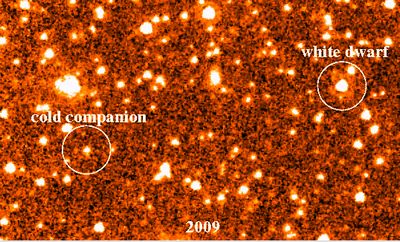
These two infrared images were taken by NASA's Spitzer Space Telescope in 2004 and 2009. They show a faint object moving through space together with a dead star called a white dwarf. The object, thought to be a "failed" star, or brown dwarf, is the coldest stellar companion to be directly imaged outside our solar system. Credit: NASA/JPL-Caltech/Penn State
NASA's Spitzer Space Telescope has captured a picture of a nearby star and its orbiting companion -- whose temperature is like a hot summer day in Arizona. "We have discovered a new record-holder for the coldest companion imaged outside of the solar system, which is nearly as cold as Earth," said Kevin Luhman, an astronomer at The Pennsylvania State University, University Park, and lead author of a pair of papers on the findings in The Astrophysical Journal. "We believe the object is a brown dwarf, but it could be a gas-giant planet as well."
Based on the infrared light that it emits, the cool object, named WD 0806-661 B, appears to have a temperature in the range of 80 and 160 degrees Fahrenheit (about 27 to 70 degrees Celsius). On the lower end, WD 0806-661 B offers a rather pleasant terrestrial temperature and is not even as warm as the human body. Researchers ballpark WD 0806-661 B's mass between six and nine Jupiters, which means it could still qualify as a planet, albeit a particularly hefty one made mostly of gas. Instead, they suspect it's a type of failed star, called a brown dwarf.
WD 0806-661 B probably belongs to a recently discovered new class of objects called Y dwarfs, the coldest category of brown dwarfs. Astronomers using NASA's Wide-field Infrared Survey Explorer (WISE) announced the unveiling of the first six Y dwarfs in August. Those objects do not orbit stars and instead are floating by themselves in space, unlike WD 0806-661 B. Together, WISE and Spitzer are proving complementary in tracking down ever-cooler brown dwarfs, all the way down to the Y class.
See the website for more details: http://www.nasa.gov/mission_pages/spitzer/news/spitzer20111019b.html (SY)
